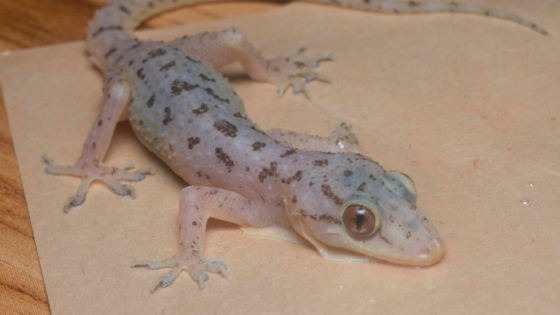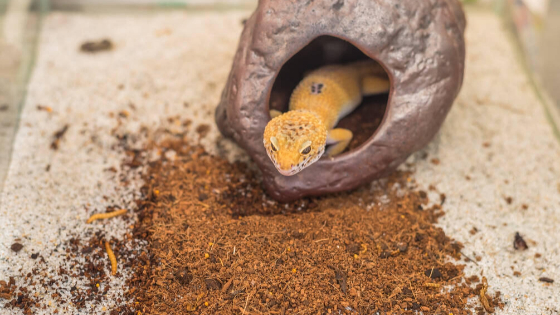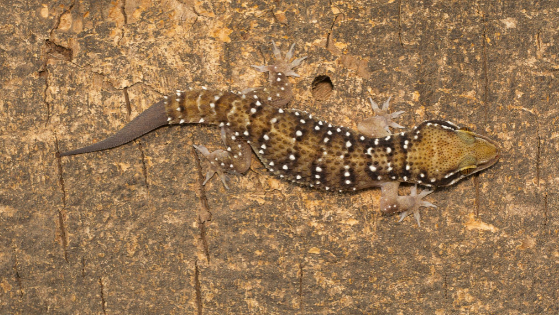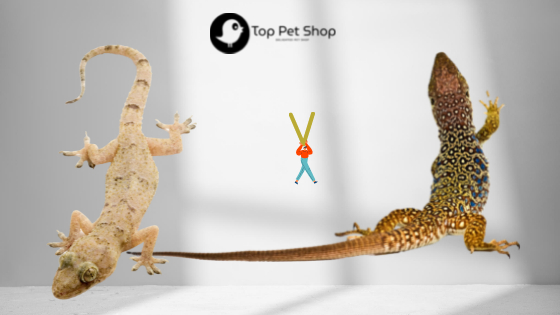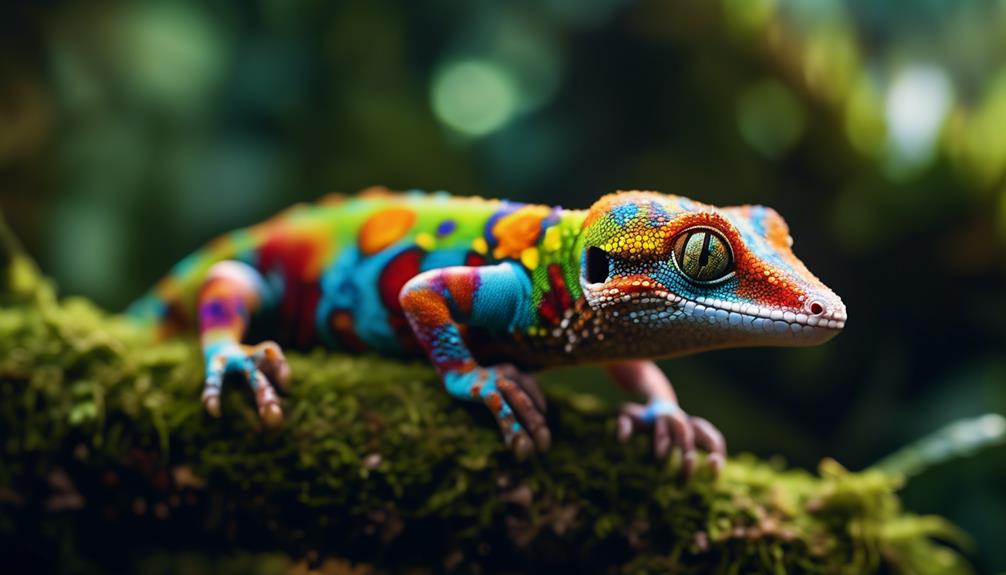
The world of taxonomy is often shrouded in mystery, as scientists tirelessly work to unravel the intricate web of classification. Recently, a rare and elusive creature, the crested gecko, has taken center stage in this captivating journey.
From its initial description in 1866 to its recent rediscovery, the crested gecko has undergone a remarkable taxonomic transformation. This intriguing tale not only sheds light on the history and changes in its classification, but also offers a glimpse into the unique adaptations and conservation efforts surrounding this mesmerizing reptile.
As we delve into the fascinating realm of the crested gecko’s taxonomic journey, we are left wondering what other secrets this remarkable species holds.
Key Takeaways
- The crested gecko, scientifically known as Correlophus ciliatus, was first described in 1866 and later renamed Rhacodactylus ciliatus.
- Recent phylogenetic analysis has reclassified 55 species from Rhacodactylus back to Correlophus, highlighting the taxonomic changes in this species.
- The geckos are endemic to the South Province of New Caledonia and are found in tropical rainforests and canopy areas.
- Threats to their habitat include wildfires, introduced species, and habitat degradation, which have led to their previously believed extinction before being rediscovered in 1994.
Taxonomic History and Classification Changes
Throughout the years, the taxonomic history and classification of the crested gecko, scientifically known as Correlophus ciliatus, has undergone significant changes and revisions.
This species was first described in 1866 by Alphone Guichenot as Correlophus ciliatus, but it was later renamed Rhacodactylus ciliatus.
However, recent phylogenetic analysis has led to the reclassification of 55 species from Rhacodactylus back to Correlophus.
The specific name, ciliatus, refers to the crest of skin over the animal’s eyes resembling eyelashes.
These taxonomic changes highlight the ongoing efforts to better understand the genetic relationships and evolutionary history of the crested gecko.
Description of the Crested Gecko
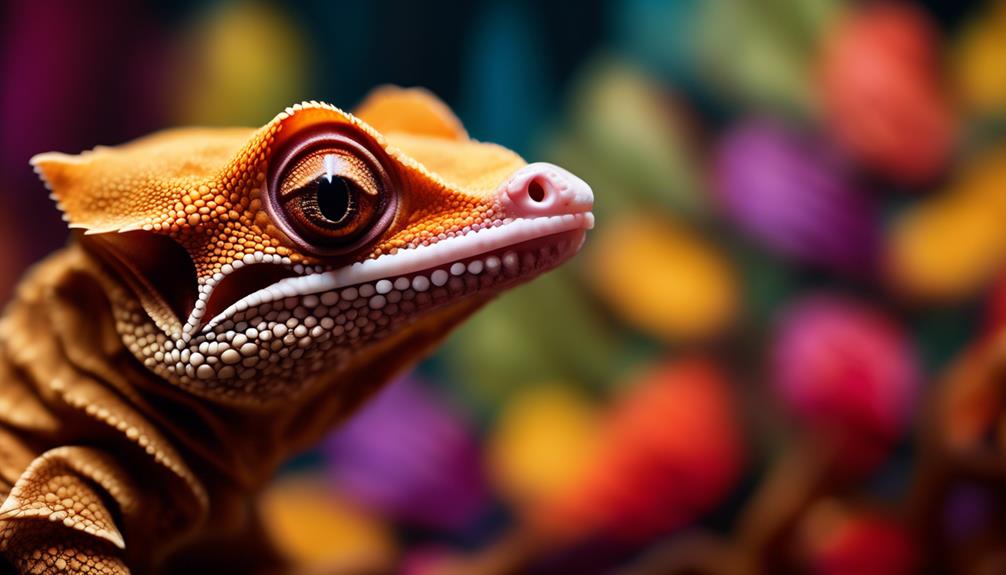
The crested gecko, scientifically known as Correlophus ciliatus, exhibits a unique set of physical characteristics that distinguish it from other gecko species. This species ranges from 8 to 10 inches in length, including the tail.
One of its most distinctive features is the presence of eyelash-like projections above its eyes. These geckos also have a semi-prehensile tail, which they use for climbing and can be dropped as a defense mechanism to distract predators. The toes and tail are covered in small hairs called setae, which aid in climbing.
The crested gecko displays various color morphs, including shades of grey, brown, red, orange, and yellow. These physical attributes contribute to the overall uniqueness of this fascinating species.
Distribution and Habitat of the Rare Gecko
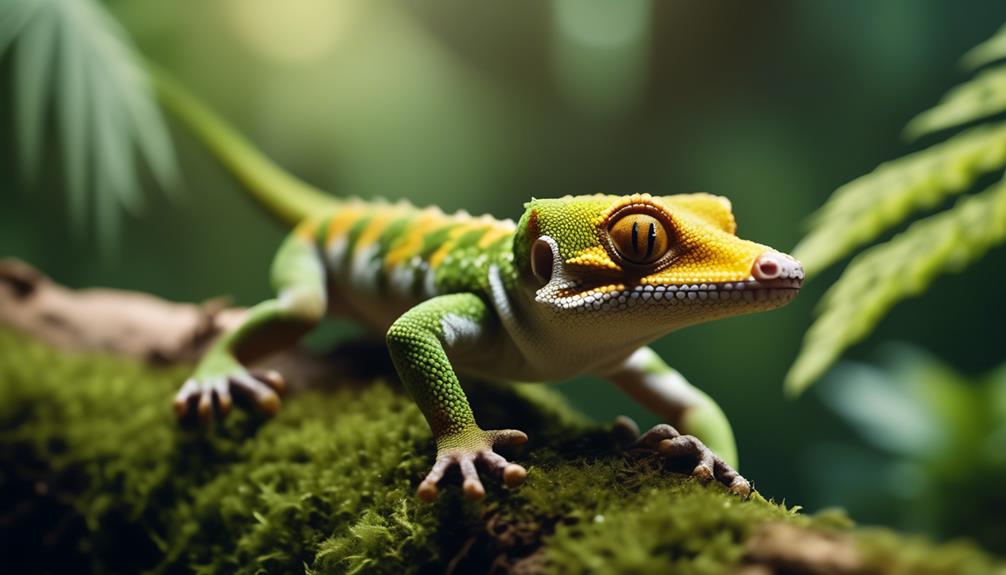
Endemic to the South Province of New Caledonia, the rare crested gecko can be found in three disjunct populations.
The first population is located on the Isle of Pines and surrounding islets, while the second population is found in the Blue River area. The third population resides in the southern region of Mount Dzumac.
These geckos thrive in tropical climates, specifically in rainforests and canopy areas. However, their habitat is under threat from factors such as wildfires, introduced species, and habitat degradation.
It is crucial to preserve and protect these habitats to ensure the survival of the rare crested gecko. By understanding their distribution and habitat requirements, conservation efforts can be better tailored to safeguard their future.
Significance of Its Rediscovery
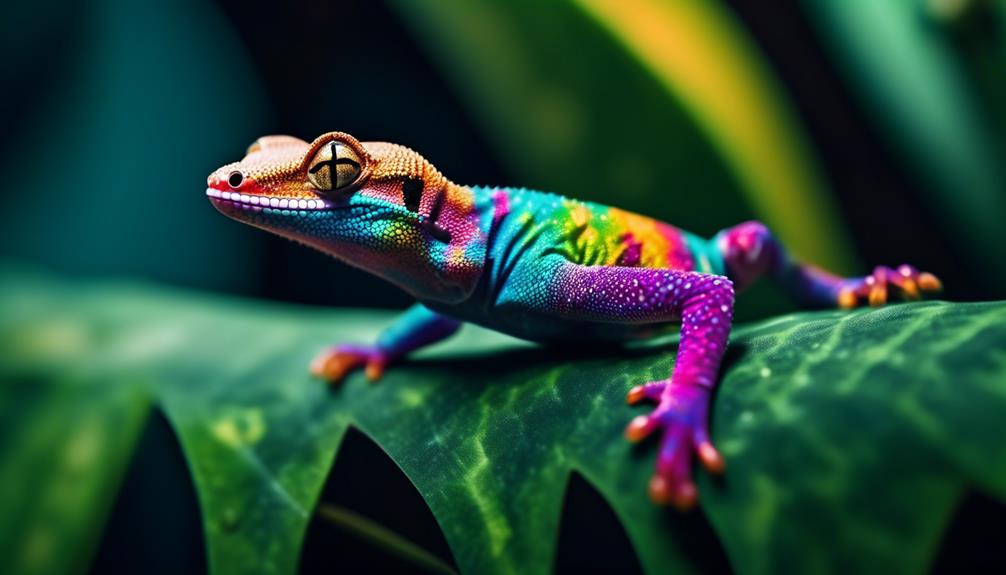
The rediscovery of the rare crested gecko holds great significance, shedding light on the species’ survival and raising important questions about its conservation status.
Previously believed to be extinct, the rediscovery in 1994 confirmed the continued existence of this unique reptile.
The crested gecko’s reappearance highlights the importance of thorough surveys and monitoring efforts to identify and protect rare and elusive species. It also underscores the need for conservation measures to safeguard their habitats.
The rediscovery of the crested gecko prompts further investigation into its distribution, population size, and the factors that have contributed to its decline. This knowledge is crucial for developing effective conservation strategies and ensuring the long-term survival of this remarkable species.
The rediscovery of the rare crested gecko serves as a reminder of the fragility of biodiversity and the urgency to protect and preserve Earth’s rich and diverse ecosystems.
Phylogenetic Analysis and Reclassification
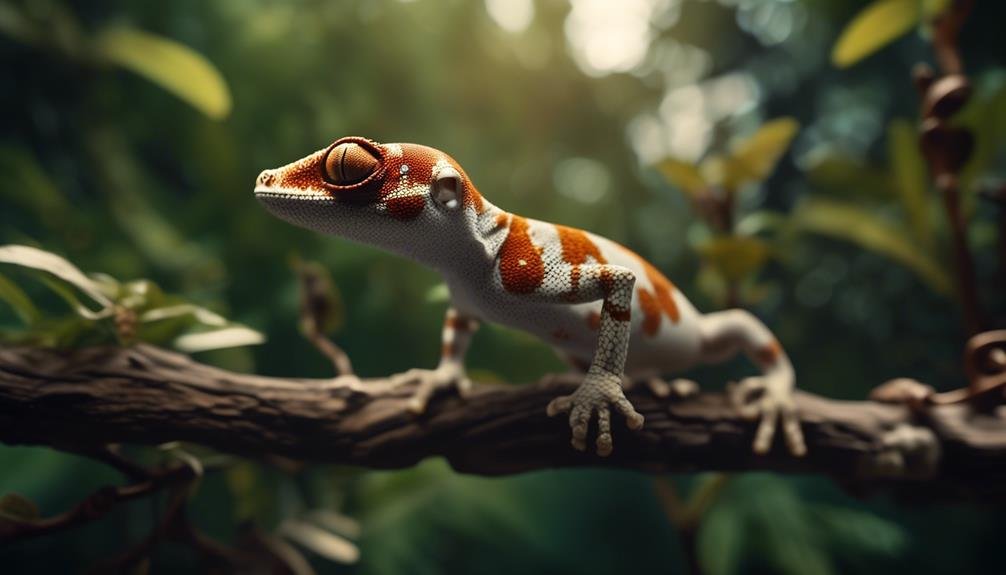
Phylogenetic analysis and subsequent reclassification have played a crucial role in understanding the taxonomic journey of the rediscovered rare crested gecko. Here are four key points about the phylogenetic analysis and reclassification of this species:
- Initial classification: The species was first described in 1866 as Correlophus ciliatus by Alphone Guichenot. It was later renamed Rhacodactylus ciliatus.
- Recent reclassification: A recent phylogenetic analysis has resulted in the reclassification of 55 species from Rhacodactylus back to the original genus Correlophus.
- Taxonomic history: The species has undergone several changes in its taxonomic classification over the years, highlighting the complexities of taxonomy and the need for accurate phylogenetic analysis.
- Crested gecko features: The name ‘ciliatus’ refers to the crest of skin over the gecko’s eyes, resembling eyelashes. This distinctive feature has played a role in the species’ classification and identification.
Unique Physical Features of the Crested Gecko
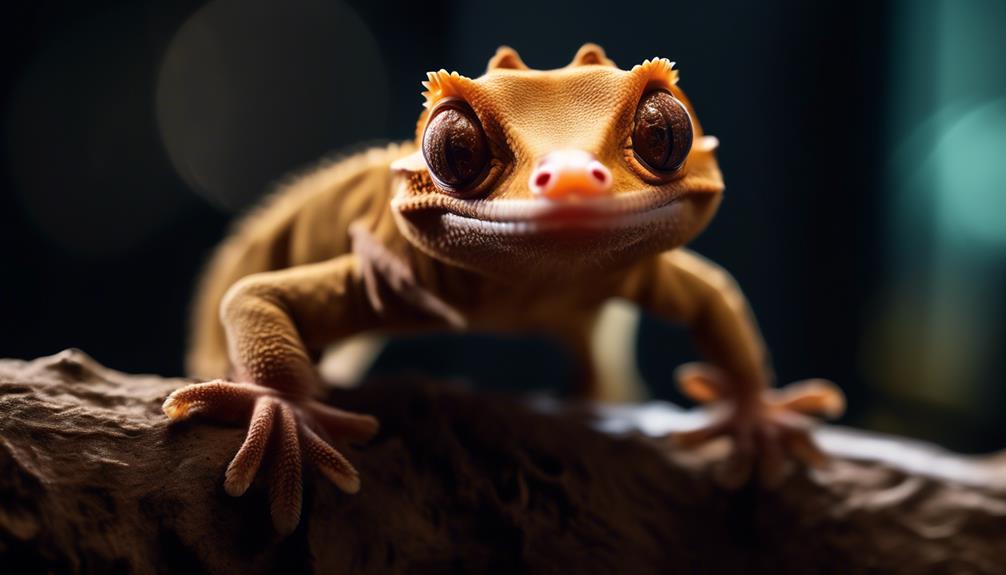
With its distinctive physical attributes, the crested gecko stands out as a unique and captivating species. Ranging from 8 to 10 inches in length, including the tail, the crested gecko possesses a variety of fascinating features.
One of its most notable characteristics is the presence of eyelash-like projections above its eyes, which resemble crests of skin and give the gecko its name. These crests add to the gecko’s charm and contribute to its overall allure.
Additionally, the crested gecko has a semi-prehensile tail, which it can use for climbing and as a defense mechanism by dropping it to distract predators. Its toes and tail are covered in small hairs, known as setae, which aid in climbing.
The crested gecko exhibits various color morphs, including shades of grey, brown, red, orange, and yellow, further adding to its visual appeal. Overall, these unique physical features make the crested gecko an intriguing and captivating species to study and admire.
Ecology and Behavior of the Species
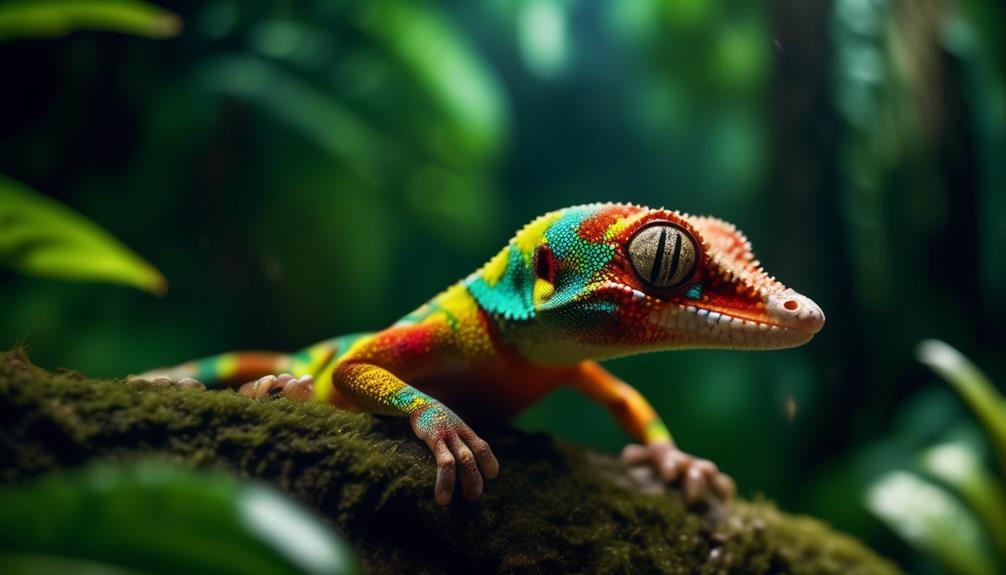
Inhabiting the lush rainforests of New Caledonia, the crested gecko demonstrates a predominantly arboreal lifestyle. Here are four fascinating facts about the ecology and behavior of this species:
- Nocturnal Habits: The crested gecko is primarily active at night, seeking secure spots to sleep during daylight hours.
- Varied Diet: These geckos have an omnivorous diet, feeding on a range of foods including fruit, nectar, pollen, and insects.
- Rediscovery: The crested gecko was previously believed to be extinct until its rediscovery in 1994, making it a species of great interest to biologists.
- Conservation Concerns: The wild population of crested geckos faces threats from introduced species and habitat damage, highlighting the need for conservation efforts.
Understanding the ecology and behavior of the crested gecko is crucial for ensuring its survival in its natural habitat.
Threats to the Wild Population
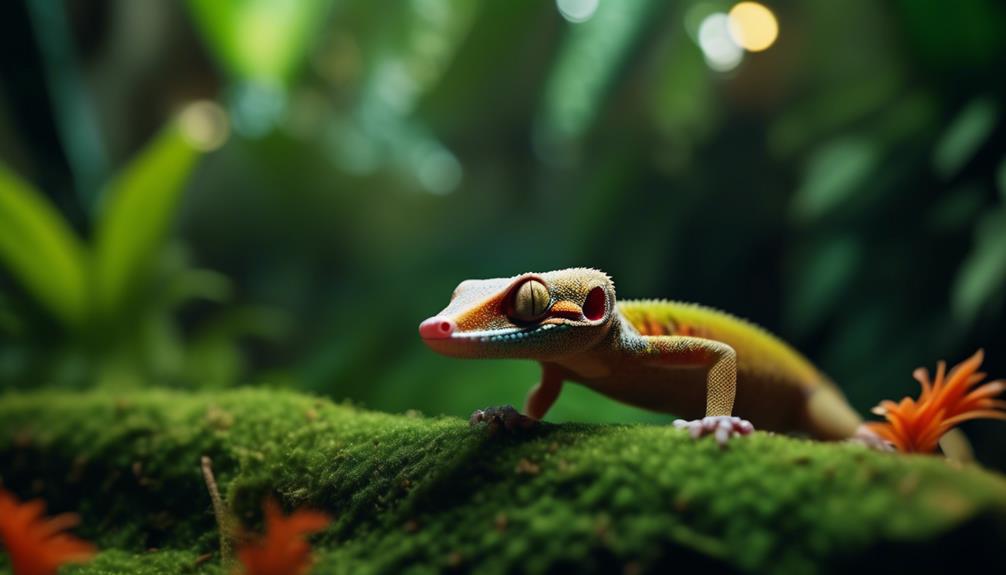
The wild population of crested geckos faces significant threats to their survival in their natural habitat. One of the main threats is the introduction of non-native species. These invasive species, such as rats and cats, prey on the geckos and compete with them for resources.
Additionally, habitat degradation poses a major risk to the wild population. Deforestation, wildfires, and human activities such as mining and agriculture result in the loss and fragmentation of the geckos’ habitat. This disrupts their natural behaviors, limits their access to food and shelter, and reduces their chances of survival.
Conservation efforts are crucial to mitigate these threats and protect the remaining wild population of crested geckos.
Reproductive Behavior and Breeding Cycle
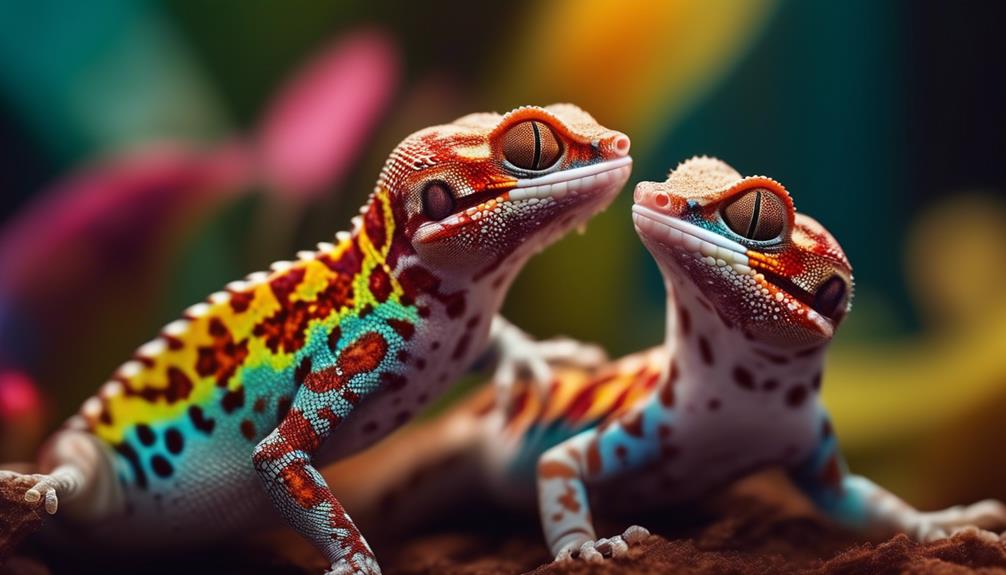
Limited information is available on the reproductive behavior and breeding cycle of crested geckos in the wild, with most knowledge being obtained from captive animals. However, understanding these aspects is crucial for the conservation of this rediscovered rare species.
Here are four key points about the reproductive behavior and breeding cycle of crested geckos:
- Clutch size: Females lay two eggs per clutch, which is a relatively small number compared to other gecko species.
- Incubation period: The eggs of crested geckos hatch after a period of 60-150 days, indicating a relatively long incubation period.
- Breeding cycle: Females can lay eggs every 4-6 weeks, suggesting a breeding cycle of approximately 8-10 months.
- Cooling cycle: After breeding, female geckos undergo a cooling cycle to regain body mass and nutrients, which is an important part of their reproductive process.
Understanding the reproductive behavior and breeding cycle of crested geckos is essential for their successful conservation and management in both captive and wild populations. Further research is needed to uncover more details about these aspects in their natural habitat.
Incubation Period and Hatching
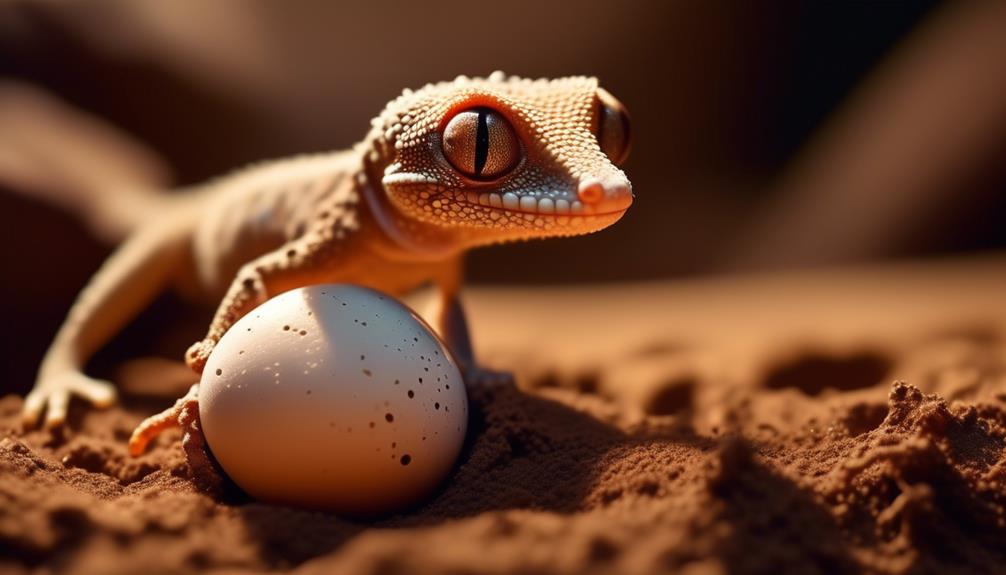
Understanding the reproductive behavior and breeding cycle of crested geckos is crucial for their conservation, and a key aspect of this is the incubation period and hatching process. Limited information on wild reproductive behavior has been obtained mostly from captive animals. Females lay two eggs per clutch, which hatch after an incubation period of 60-150 days. Females can lay eggs every 4-6 weeks, resulting in a breeding cycle of 8-10 months. It is important for females to undergo a cooling cycle after breeding to regain body mass and nutrients. Calcium deficiency can occur in egg-laying females if they do not have enough calcium. The table below provides a summary of the incubation period and hatching process for crested geckos:
| Aspects | Incubation Period | Hatching Process |
|---|---|---|
| Eggs per clutch | 2 | |
| Incubation period | 60-150 days | |
| Breeding cycle | 8-10 months | |
| Cooling cycle |
Importance of Calcium in Egg-Laying Females
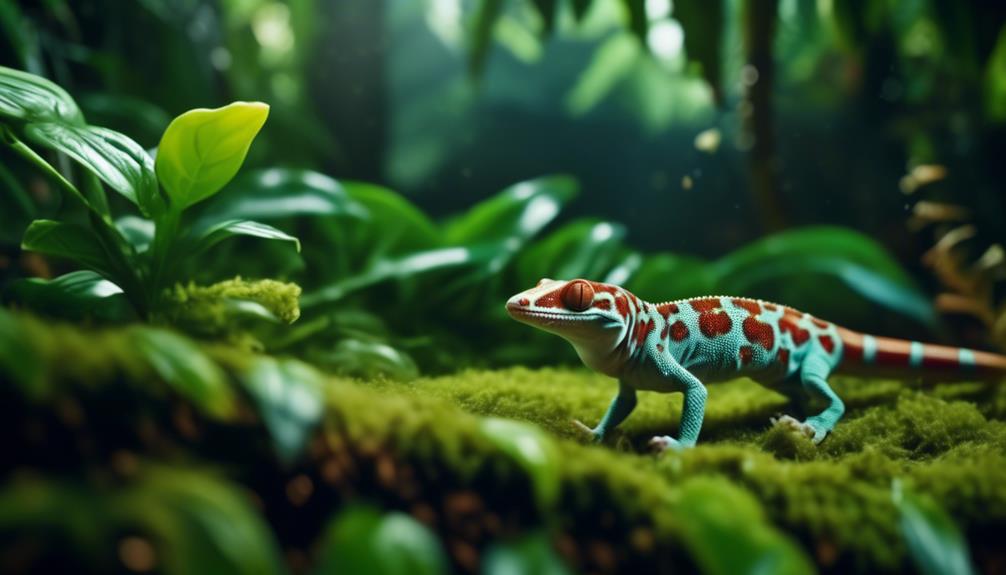
Calcium plays a crucial role in the reproductive health of egg-laying females. Here are four reasons why calcium is important for these females:
- Eggshell Formation: Calcium is a vital component for the formation of strong and healthy eggshells. It provides the necessary structural support to protect the developing embryos.
- Muscle Function: Calcium is essential for proper muscle function, including the contraction of muscles involved in egg laying. Without sufficient calcium, females may experience muscle weakness, leading to difficulties in laying eggs.
- Skeletal Health: Calcium is necessary for maintaining strong and healthy bones. Egg-laying females need to replenish the calcium stores depleted during egg production to prevent bone weakness and fractures.
- Hormone Regulation: Calcium is involved in hormone regulation, including the production and release of reproductive hormones. Adequate calcium levels ensure proper hormonal balance, which is crucial for successful egg laying.
Conservation Efforts and Initiatives
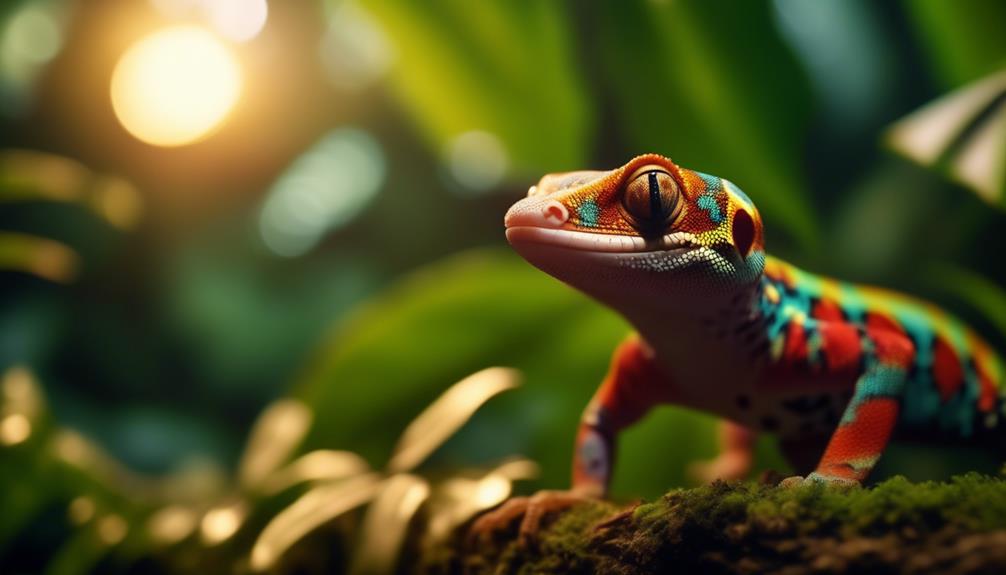
What measures are being taken to conserve and protect the rare and rediscovered crested gecko species in its native habitat of South Province, New Caledonia?
Conservation efforts and initiatives are crucial for the survival and protection of the crested gecko species in its native habitat. Various organizations and institutions are working together to implement conservation strategies. These include conducting research to better understand the species’ ecology and behavior, identifying key threats to its habitat, and developing measures to mitigate those threats.
Additionally, efforts are being made to raise awareness about the importance of conserving this rare species among local communities and stakeholders. Collaboration with local authorities and implementing strict regulations to prevent illegal trade and poaching is also a priority.
Implications for Future Research
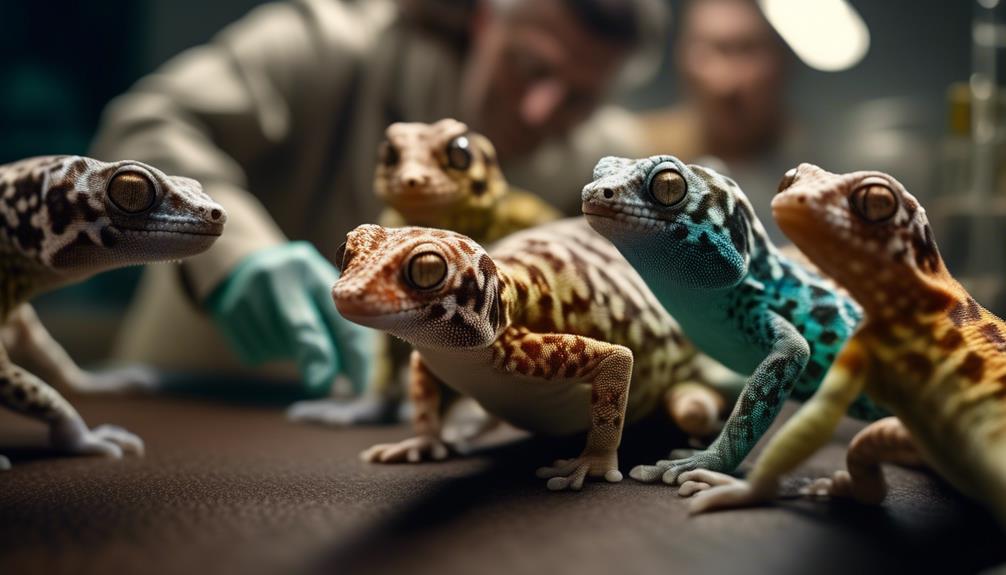
Conservation efforts and initiatives are essential for the protection and survival of the crested gecko species, and understanding the implications for future research is crucial in ensuring the long-term success of these conservation measures. Here are four key implications for future research:
- Taxonomic reassessment: The recent taxonomic journey of the crested gecko highlights the need for ongoing research to clarify its classification. Further studies are required to elucidate its genetic diversity, evolutionary relationships, and potential new species.
- Habitat and population monitoring: Continued research is necessary to monitor the distribution, population size, and habitat quality of the crested gecko. This will help identify areas of conservation concern and guide effective management strategies.
- Threat assessment and mitigation: Research should focus on assessing and mitigating the threats faced by crested geckos, such as habitat degradation, wildfires, and introduced species. Understanding the impact of these threats will aid in developing targeted conservation actions.
- Reproductive biology and captive breeding: Further research into the reproductive behavior, breeding success, and captive breeding techniques will be crucial for the long-term conservation of the species. This will enable the development of effective breeding programs to supplement wild populations and mitigate the risk of extinction.
Conclusion and Potential Implications for Other Species
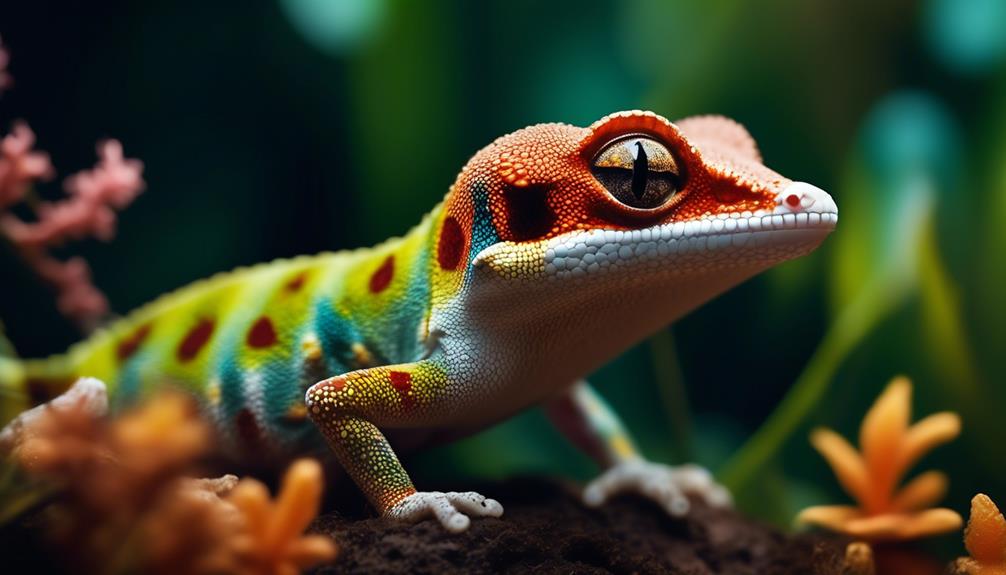
In light of the taxonomic journey and conservation implications of the rediscovered crested gecko, the conclusion of this study holds potential implications for other species as well.
The reclassification of the crested gecko from Rhacodactylus back to Correlophus highlights the importance of continuous taxonomic research and revision. It underscores the need for scientists to reassess species classifications based on new information and advancements in phylogenetic analysis.
This case study also emphasizes the significance of rediscoveries in conservation efforts. The crested gecko was previously believed to be extinct, but its rediscovery in 1994 led to increased efforts in protecting its habitat and population.
This serves as a reminder that other species considered extinct or rare may still exist, urging scientists and conservationists to continue their efforts in locating and preserving these species.
Frequently Asked Questions
How Did the Taxonomic History and Classification of the Crested Gecko Change Over Time?
The taxonomic history and classification of the crested gecko, Correlophus ciliatus, has undergone changes over time. Initially described as Rhacodactylus ciliatus in 1866, recent phylogenetic analysis reclassified 55 species back to Correlophus.
What Are the Unique Physical Features of the Crested Gecko That Distinguish It From Other Gecko Species?
The crested gecko, Correlophus ciliatus, possesses unique physical features that distinguish it from other gecko species, including the presence of eyelash-like projections above the eyes and a semi-prehensile tail for climbing.
What Are the Threats to the Wild Population of Crested Geckos and Their Habitat?
The threats to the wild population of crested geckos and their habitat include wildfires, habitat degradation, and the introduction of non-native species. These factors pose a significant risk to the survival of the species in its natural environment.
How Long Is the Incubation Period for Crested Gecko Eggs and What Is the Hatching Process Like?
The incubation period for crested gecko eggs is 60-150 days. The hatching process involves the eggs being laid by the female, followed by incubation in a suitable environment until they hatch.
What Are the Implications of the Rediscovery of the Crested Gecko for Future Research and Potential Implications for Other Species?
The rediscovery of the crested gecko has significant implications for future research, as it provides an opportunity to further study its ecology, behavior, and conservation needs. Additionally, it highlights the importance of thorough taxonomic investigations and the potential for reclassification in other species.
How Do Invasive Mediterranean House Geckos Impact the Habitat of Crested Geckos?
The presence of invasive Mediterranean house geckos can negatively impact the habitat of crested geckos. Competition for resources such as food and shelter may increase, leading to potential displacement of the crested geckos. Additionally, the invasive geckos may introduce new diseases, posing further threats to the native crested gecko population.
Conclusion
In conclusion, the rediscovery of the crested gecko and its taxonomic journey have provided valuable insights into the intricate history and classification changes of this species.
Its distribution and habitat in the rainforests of New Caledonia highlight the need for conservation efforts to protect it from threats such as wildfires and habitat degradation.
Further research on the ecology, behavior, and reproductive patterns of the crested gecko is crucial for its preservation and may have implications for other species facing similar challenges.

